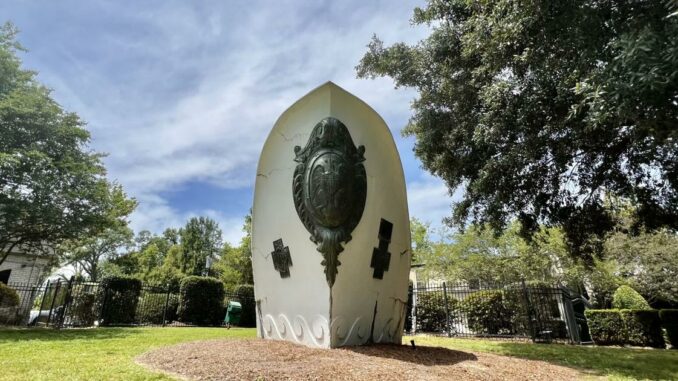
The Spanish-American War Memorial, also known as the U.S.S. Louisiana Monument, has been standing in City Park since 1939, when it was moved from its former home at Louisiana’s Old State Capitol.
Those passing by may see it at the intersection of Dalrymple Drive and Broussard Street but few pay it much attention.
It’s a painted concrete structure, nautical in style, strange in placement. Is it a ship? Well, sort of.
Yes, Baton Rouge’s ode to a ship, long landlocked, at the edge of City Park, could never be mistaken for a real water vessel.

A postcard of the U.S.S. Louisiana, which was commissioned in 1909. The brass figurehead now on the Baton Rouge monument can be seen on the ship’s prow.
It’s one of those things that most Baton Rouge residents know is there but have never taken the time to investigate.
Still, it’s well worth a closer look.
The structure’s centerpiece is the 5-foot, brass figurehead bearing the Great Seal of the United States that once fronted the battleship U.S.S. Louisiana. The ship once was part of President Theodore Roosevelt’s Great White Fleet of 16 battleships in the Pacific Ocean.
That was the color of the ships before the Roosevelt ordered them repainted gray as camouflage on the water.
A 360-degree view of the Spanish American War Memorial in Baton Rouge’s City Park. The monument also is called the U.S.S. Louisiana Monument, because its centerpiece is the 8-foot, brass figurehead of the battleship U.S.S. Louisiana, which was commissioned in 1909. It was moved from its original home on the grounds of Louisiana’s Old State Capitol to City Park in 1939. Staff video by Robin Miller
With that background, the monument is, appropriately enough, painted white.
“It’s supposed to look like the ship’s prow,” John Sykes, executive director of BREC’s Magnolia Mound.
Sykes is working on a book about downtown Baton Rouge’s landmarks, and a folder on the U.S.S. Louisiana is included in his stack of research.
“It’s called the Spanish-American War Memorial,” he said. “But the U.S.S. Louisiana was built in 1903 and launched in 1904.”

The Spanish-American War Memorial, also known as the U.S.S. Louisiana, features the brass figurehead from the battleship Louisiana, which was commissioned in 1909.
The U.S.S. Louisiana wasn’t involved in the Spanish-American War, which began April 21, 1898, in the aftermath of an internal explosion of U.S.S. Maine in Havana Harbor, Cuba. The incident led to the United States’ intervention in the Cuban War of Independence, which ended a few weeks later on Aug. 13, 1898.
A plaque on the right side of the figurehead memorializes the sinking of the Maine. Another commemorates American warriors who served in the war: “This Figurehead from the Battleship ‘Louisiana’ is erected in memory of the soldiers and sailors who served the flag in the Spanish American War – 1898-1902. Erected MDMXXXIX.”
The Roman numerals have caused confusion over the years. A literal translation dates the monument at 1539.
“Actually, the ‘D’ should have been a ‘C’ to indicate 1939, the year the monument was set up,” Beverly Wolter wrote in 1949.
Wolter’s article appeared in The Morning Advocate March 27, 1949, apparently to answer speculative questions about the monument. It had been standing in City Park only 10 years at the time her story was published.

The Spanish-American War Memorial, also known as the U.S.S. Louisiana, features the brass figurehead from the battleship Louisiana, which was commissioned in 1909.
Wolter followed a trail of historical bread crumbs, beginning with the Louisiana’s 1904 launch in Newport News, Virginia, and includes the change of the fleet’s colors from white to gray.
“The figurehead, which weighed several tons and originally cost $17,000, was sent here, along with the brass work, which had extended for about 30 feet back on either side, Wolter wrote.
This was a mystery for Sykes.
“What bothered me was why they would take the figurehead off the boat,” he said.
Sykes eventually found the explanation of the figurehead’s removal in Hilda Krousel’s book, “Landmarks & Monuments in Baton Rouge.” Roosevelt ordered all ornamentation taken off warships after they were painted gray to prevent interference with the camouflage effect.
“So it makes sense,” he said.
Meanwhile, Sykes discovered that Louisiana Congressman Robert Charles Wickliffe of St. Francisville was responsible for bringing the figurehead to Baton Rouge in 1909. This would have been three years after the 16,000-ton battleship was commissioned by the U.S. Navy.

The 8-foot, brass figurehead from the U.S.S. Louisiana, which was commissioned in 1909, is the centerpiece of the Spanish-American War Memorial, also known as the U.S.S. Louisiana Monument in City Park.
Wickliffe previously enlisted as a private in Company E, First Regiment, Louisiana Volunteer Infantry, during the Spanish–American War, which might account for his interest in commemorating the war.
The monument stood next to Louisiana’s Old State Capitol until 1937, when it was uprooted and stored in its basement during renovation of the building and grounds.
“In 1939, J. St. Clair Favrot had it moved to City Park,” Sykes said. “He was the state’s adjutant and service commissioner for Spanish-American War veterans. He had an office in the Old Capitol, and he worked with local veterans to create a memorial to the state’s veterans of the war.”

Ornamentation represents ocean waves at the bottom of the nautical Spanish-American War Memorial in City Park. The monument’s centerpiece is the brass figurehead from the U.S.S. Louisiana.
Favrot enlisted Frederick von Osthoff, assistant to LSU’s dean of administration, to design the ship prow monument. City engineer L.J. Voorhies spearheaded its construction, which was carried out by brick mason, August Ledoux.
“Ledoux also built the columns at the entrance of Steele Boulevard,” Sykes said.
He added that the Steele Boulevard columns are beautiful, but may look out of place as one drives along Claycut Road.

A brass plaque commemorates the service of the American soldiers and sailors in the Spanish-American War beneath another memorializing the Americans who lost their lives on the U.S.S. Maine explosion in Havana Harbor in 1898 on the Spanish American War Memorial in City Park.
Even so, the ship’s prow on Dalrymple looks even more out of place. Yet this is where it’s stood since its 1939 unveiling by U.S. Secretary of War Harry Woodring.
“There’s also another story connected to this,” Sykes said. “The State-Times ran a photo in 1949 of three children at the monument.”
The State-Times was the older, afternoon sister paper to The Morning Advocate. The photo ran Nov. 25, 1949, the Friday following Tulane University’s football win over LSU in Tiger Stadium the previous weekend.

A brass plaque memorializes the United States’ involvement in the Spanish-American War on the Spanish American War Memorial in City Park. The monument’s centerpiece is the figurehead from the U.S.S. Louisiana.
Tulane fans celebrated by painting their university’s initials, “TU” in green on the monument. The children in the newspaper photograph were Wickliffe’s grandchildren, Robert Wickliffe Fenet, Courtney Ashton Fenet Jr. and Brent Fenet, ages 10, 9 and 8. The three were covering the vandalism with white paint.
“The irony was that their grandfather was a Tulane alumnus,” Sykes said.

The Spanish-American War Memorial, also called the U.S.S. Louisiana Monument, has been standing in City Park since 1939.
As for the Louisiana, it was decommissioned and scrapped in 1922, while its figurehead continues its symbolic sail in Baton Rouge’s City Park.



Leave a Reply